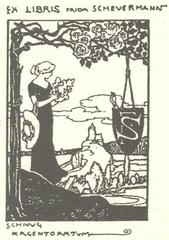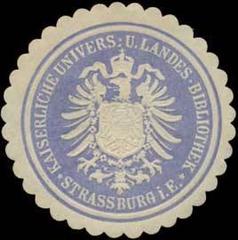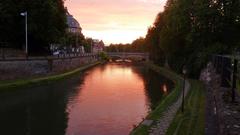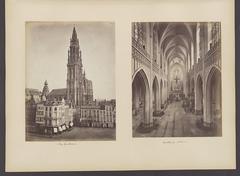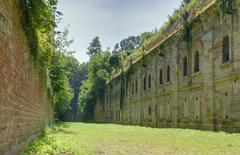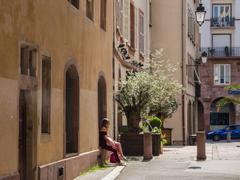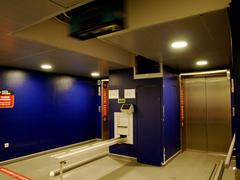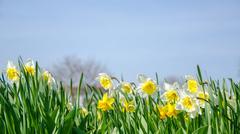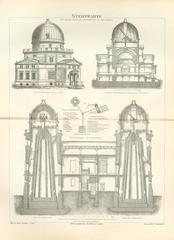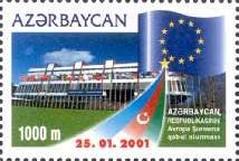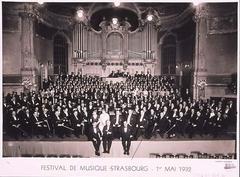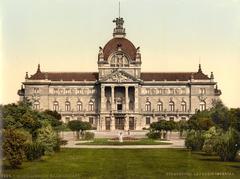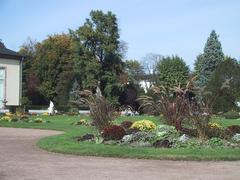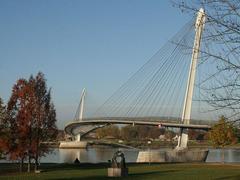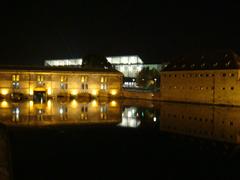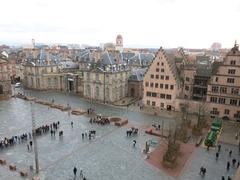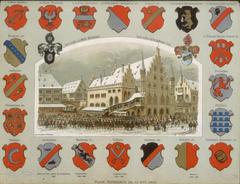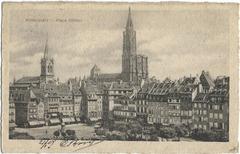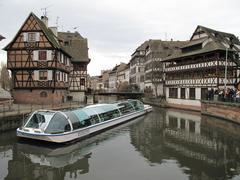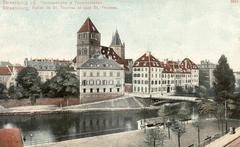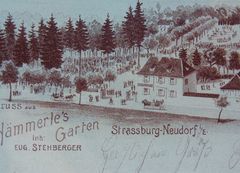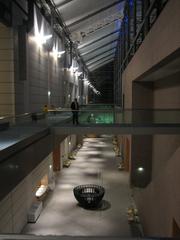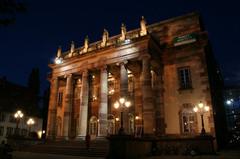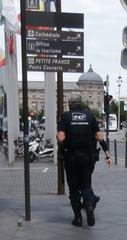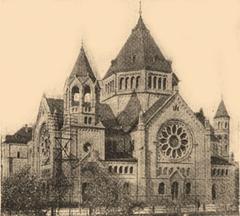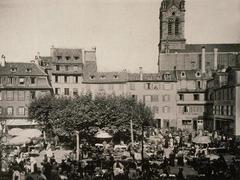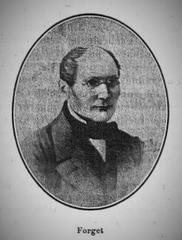
Palais Universitaire Strasbourg: Visiting Hours, Tickets, and Historical Sites Guide
Date: 04/07/2025
Introduction
Nestled in Strasbourg’s UNESCO-listed Neustadt district, the Palais Universitaire stands as a magnificent symbol of Franco-German heritage, academic excellence, and neo-Renaissance architecture. Built between 1879 and 1884 under the German Empire, this imposing structure continues to play a pivotal role in Strasbourg’s academic and cultural life. Its grand façade, adorned with allegorical sculptures and statues of renowned scholars, reflects the ambitions of its creators and the city’s evolving identity. Today, the Palais Universitaire is both an active university building and a celebrated historical site, offering visitors a unique opportunity to experience Strasbourg’s rich intellectual and architectural legacy. This guide provides comprehensive information on visiting hours, tickets, accessibility, architectural highlights, nearby attractions, and practical tips to ensure a memorable visit (strasbourg.eu, jardin-sciences.unistra.fr, Visit Strasbourg).
Table of Contents
- Historical Background and Urban Context
- Architectural Significance and Artistic Features
- Cultural Significance and Public Engagement
- Visiting the Palais Universitaire: Practical Information
- Visitor Facilities and Amenities
- Guided Tours and Educational Experiences
- Best Times to Visit and Practical Tips
- Safety, Etiquette, and Accessibility
- Nearby Attractions and Suggested Itineraries
- Frequently Asked Questions
- Preservation and Contemporary Relevance
- Conclusion
- References and Further Reading
Historical Background and Urban Context
Foundation and Political Context
The origins of the Palais Universitaire are deeply tied to the shifting tides of European history. Following the annexation of Alsace-Lorraine by the German Empire after the Franco-Prussian War (1870–1871), German authorities sought to reinforce their cultural influence by establishing a prominent university in Strasbourg. The new Kaiser Wilhelms Universität was officially inaugurated in 1872, and the construction of the Palais Universitaire began soon after, culminating in its opening in 1884 (strasbourg.eu, jardin-sciences.unistra.fr).
Urban Integration and the Neustadt District
The Palais Universitaire anchors the Neustadt district, a model of late-19th-century urban planning characterized by monumental boulevards, public institutions, and expansive green spaces. The university campus was strategically positioned at one end of Avenue de la Liberté, facing the Palais du Rhin, to symbolize the dialogue between knowledge and imperial power. The campus is further enriched by the adjacent Jardin Botanique and Astronomical Observatory, reinforcing its educational mission (strafari.com).
Symbolism and Urban Identity
The building’s grand scale, decorative program, and alignment with the city’s imperial axis project an image of intellectual and political ambition. The nearby statue of Johann Wolfgang Goethe at Place de l’Université commemorates Strasbourg’s academic heritage and its lasting ties to European culture (strasbourg.eu).
Architectural Significance and Artistic Features
Exterior Grandeur
Designed by Otto Warth, the Palais Universitaire is a masterpiece of neo-Renaissance architecture. Its monumental grey sandstone façade features thirty-three bays, three projecting pavilions, and a central sculptural group depicting Athena, flanked by allegories of science. Thirty-six statues of eminent scholars adorn the exterior, underscoring the building’s academic mission (strasbourg.eu).
Interior Highlights
The centerpiece of the interior is the luminous Aula, a grand ceremonial hall surrounded by teaching rooms and offices. Restored murals and ornamental plasterwork celebrate science, the arts, and Strasbourg’s academic legacy. The building also houses the Musée des Moulages, an extensive collection of plaster casts of classical sculptures, assembled by Adolf Michaelis (jardin-sciences.unistra.fr).
Artistic Details
Allegorical murals, sculpted busts, wrought iron balustrades, and stained-glass windows contribute to the Palais Universitaire’s rich artistic heritage. The inscription “Litteris et Patriae” (“For Letters and the Fatherland”) reinforces its educational mission.
Cultural Significance and Public Engagement
A Hub of Academic and Civic Life
As the central building of the University of Strasbourg, the Palais Universitaire hosts lectures, research, doctoral ceremonies, and international conferences. It also serves as a prestigious venue for concerts, exhibitions, and civic events, fostering dialogue between academia and the wider community (maltacoe.gov.mt).
Historical Events
The Palais Universitaire has witnessed major historical milestones, including the founding of the Council of Europe in Strasbourg and post-war ceremonies symbolizing European unity (monumentum.fr).
Visiting the Palais Universitaire: Practical Information
Location and Access
- Address: 9 Place de l’Université, Strasbourg, France
- Getting There: Easily accessible by tram (Lines C, E, F; stop “Université”), bicycle, or on foot. Limited parking is available; public transport is recommended (Visit Strasbourg).
Visiting Hours
- Exterior and gardens: Open daily, 24/7
- Interior access: Monday to Friday, 9:00 AM to 6:00 PM; closed on weekends and public holidays. Access may be restricted during academic events.
Tickets and Entry
- Exterior and gardens: Free access at all times
- Guided tours/interior access: Free or ticketed, depending on the event or tour; advance booking recommended for guided visits (jardin-sciences.unistra.fr)
Visitor Facilities and Amenities
- Restrooms: Available inside university buildings during opening hours
- Dining: Numerous cafés and restaurants nearby, especially along Quai du Maire Dietrich and in the student district
- Gardens: Landscaped areas ideal for relaxation, picnics, and photography
- Accessibility: Main entrances and gardens are accessible to visitors with reduced mobility; some interior spaces may have limitations due to historic features
Guided Tours and Educational Experiences
- Guided Tours: Thematic tours are offered by the Strasbourg Tourist Office and the University’s Jardin des Sciences, covering the façade, Aula, arcaded galleries, and the Musée des Moulages. Tours last about 1 hour and 15 minutes and are suitable for adults and adolescents aged 15+ (jardin-sciences.unistra.fr)
- Audio Guides: Available for self-guided exploration of the exterior and Neustadt district
- Special Events: The Aula and other spaces occasionally host public lectures, concerts, and exhibitions
Best Times to Visit and Practical Tips
- Best Months: April–June and September–October, when gardens are at their peak (Destination Abroad)
- Photography: Early morning or late afternoon offers optimal light and fewer crowds
- Weather: Strasbourg weather can be variable; umbrellas or raincoats are advised year-round (Dabbling in Jetlag)
- Language: French is the primary language, though English is widely understood in tourist areas
- Events: Check the university and tourist office websites for special events, open days, and concerts
Safety, Etiquette, and Accessibility
- Strasbourg is a safe city; standard precautions apply
- The university district is lively and welcoming during the day
- Respect academic activities and event-specific restrictions, especially during lectures or examinations
- The main entrance and gardens are accessible; contact the university in advance for specific mobility requirements (Visit Strasbourg)
Nearby Attractions and Suggested Itineraries
- Palais du Rhin: Former imperial palace, directly opposite the university
- Bibliothèque Nationale et Universitaire (BNU): Grand library adjacent to the Palais Universitaire
- Jardin Botanique: Botanical gardens behind the university, open to the public
- Place de la République: Majestic square surrounded by historic buildings
- Grande Île: Strasbourg’s historic center, cathedral, and Petite France, about 15 minutes’ walk away
Suggested Itinerary: Begin at the Palais Universitaire, explore the Neustadt district, visit the botanical garden, and then head to Grande Île for lunch and sightseeing.
Frequently Asked Questions
Q: What are the Palais Universitaire visiting hours?
A: The exterior and gardens are accessible at all times. Interior access is generally Monday to Friday, 9:00 AM–6:00 PM; special access is available via guided tours.
Q: Is there an entrance fee?
A: No, access to the exterior and gardens is free. Guided tours may require advance booking and may have a small fee.
Q: Is the Palais Universitaire accessible for visitors with disabilities?
A: The main entrance and gardens are accessible; some interior areas may present challenges due to the building’s historic nature.
Q: Are guided tours available?
A: Yes, guided tours are offered by Jardin des Sciences and the Tourist Office. Advance booking is recommended.
Q: Can I visit the interior without a guided tour?
A: Generally, interior access is limited to guided tours or during special events/open days.
Preservation and Contemporary Relevance
The Palais Universitaire was designated a protected historic monument in 1990, ensuring ongoing restoration and maintenance of its façades, sculptures, and interior spaces (monumentum.fr). Today, it remains central to academic and cultural life in Strasbourg, hosting research, lectures, and international events, and serving as a vibrant bridge between the city’s past and present (jardin-sciences.unistra.fr).
Conclusion
The Palais Universitaire is a must-see landmark that seamlessly blends architectural grandeur, historical depth, and contemporary academic life. Whether you admire its impressive façade and gardens or join a guided tour for exclusive interior access, you will experience the enduring legacy of Strasbourg as a crossroads of knowledge and culture. Plan your visit ahead, explore nearby Neustadt and Grande Île attractions, and immerse yourself in Strasbourg’s vibrant heritage.
For the latest information on visiting hours, tickets, and events, consult the Strasbourg Tourist Office and University of Strasbourg official website.
References and Further Reading
- Palais Universitaire Strasbourg: Visiting Hours, Tickets, and Historical Significance (strasbourg.eu)
- Guided Visits of Palais Universitaire, Jardin des Sciences, University of Strasbourg (jardin-sciences.unistra.fr)
- Palais Universitaire Historic Monument Listing, Monumentum.fr (monumentum.fr)
- Reasons to Visit Strasbourg, Strafari.com, 2025 (strafari.com)
- Palais Universitaire Visitor Guide, Jardin des Sciences (jardin-sciences.unistra.fr)
- Strasbourg Tourist Office: City Tours and Information (Visit Strasbourg)
- The Rich History of Strasbourg, World City History, 2025 (worldcityhistory.com)
- Destination Abroad
- Dabbling in Jetlag












